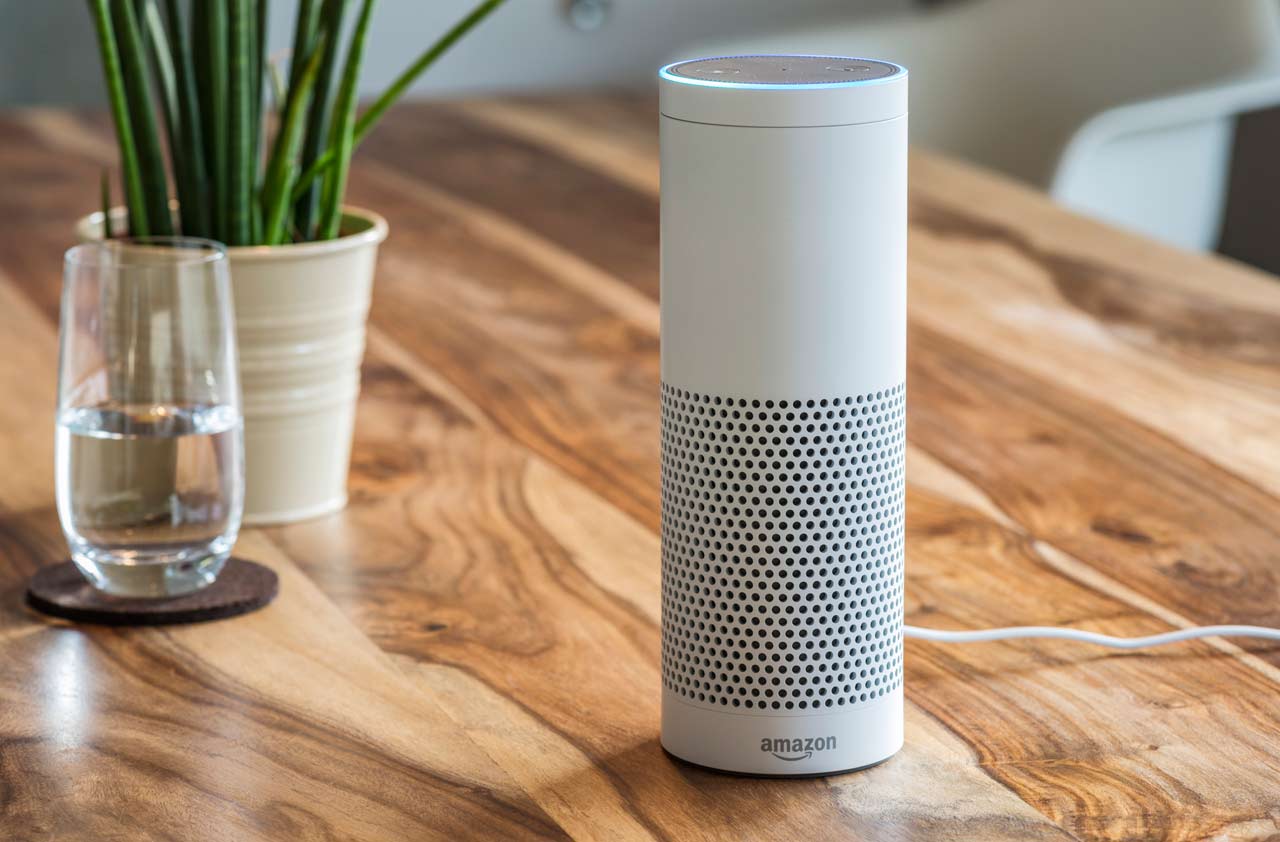Voice Assistants Can Help Older Adults
How devices including Amazon Echo and Apple HomePod can help seniors feel more connected.


Lois Seed's vision impairment makes it difficult for her to read books and to look for information on the Internet. So when her retirement community in Carlsbad, Calif., offered to place an Amazon Echo with Alexa voice technology in her one-bedroom apartment, she decided to give the home speaker a try.
Now Seed is hooked—and she’s one of a growing number of older people who are turning to digital voice assistants to make life easier. The 90-year-old widow placed the device next to a comfortable chair, where she listens to audiobooks and to classical music streamed from a radio station in Los Angeles, where she used to live. “If I no longer want to listen, I say, ‘Alexa, stop,’ ” she says. “I can make it louder or softer.”
In the morning, Seed asks Alexa for the weather and the time. And when any of her 13 grandchildren visit, they ask Alexa to play games such as Jeopardy. Seed also installed Alexa-enabled “smart home” plug-ins, which allow her to ask Alexa to turn a light on and off and to change the room temperature up or down. Before, she says, she had trouble reading and manipulating the thermostat.

Sign up for Kiplinger’s Free E-Newsletters
Profit and prosper with the best of expert advice on investing, taxes, retirement, personal finance and more - straight to your e-mail.
Profit and prosper with the best of expert advice - straight to your e-mail.
When it comes to voice assistants, Seed’s advice to seniors is to learn about the numerous functions that voice technology offers. “Ask friends and family to help you,” she says. “It can make your life more interesting.”
For many older individuals living at home, so-called voice-first technology can prolong independence and reduce social isolation, according to experts. By simply using their voices, older adults can ask their devices to call a relative, read e-mails, find recipes, set medication reminders, order a taxi or food from a favorite restaurant, and add items to a shopping list.
Also, voice-controlled technology “is a big advantage for someone in a wheelchair or for people who don’t have good use of their hands, such as someone with Parkinson’s, and find smartphones too small,” says Laurie Orlov, founder of Aging in Place Technology Watch, a market research group.
Seed was introduced to the Echo last year when she agreed to participate in a six-month pilot study at Carlsbad By The Sea, a continuing-care retirement community. The project began with 12 households and was later expanded to 90 units, with most participants in their eighties. The pilot was conducted by the Front Porch Center for Innovation and Wellbeing, which researches aging-related technology for the nonprofit Glendale, Calif., company that operates Carlsbad and other retirement communities.
Residents attended workshops where they learned about the numerous capabilities (called skills) that Alexa offers. Front Porch technicians helped users customize the skills based on their individual interests, such as connecting Seed to her favorite music station.
In the study’s findings, all participants reported that Alexa made their lives easier. More than 70% noted that the device helped them stay connected to friends, family and the community. And about 75% said they used their smart-home devices daily. “We were really floored by the level of enthusiasm,” says Davis Park, the Front Porch Center’s executive director.
Park says that even simple skills, such as setting a timer for boiling eggs, “resonated” with participants who want to maintain a sense of independence and control. “People are concerned with forgetfulness, and the ease of setting something like a timer with voice was powerful,” Park says. He says Front Porch is expanding the program to other retirement communities.
The Promise of Voice Technology for Health Care
Devices such as the Amazon Echo, Google Home and the Apple HomePod primarily help users perform everyday tasks. (The Amazon device, which leads the market, ranges in price from $40 to $100.) But now medical providers are considering the potential for voice technology to improve the health of aging-in-place seniors.
In a pilot last year, for instance, one home health agency placed Amazon Echo devices in the homes of several patients. Users could contact caregivers, receive reminders on medication and other health tasks, and schedule appointments. The agency found that the program “preserved the independence of individuals while driving better efficiency of staff,” says Nathan Treloar, president and chief operating officer of Orbita, a Boston company that develops voice-enabled software for home health care.
With Orbita software, the Mayo Clinic is providing Echo owners with first-aid advice. By saying, “Alexa, ask Mayo First Aid how to treat a cut,” the user can get instructions on taking care of such a common mishap, as well as burns, insect bites and medications.
Another company found in a pilot study that diabetes patients were more likely to stick to eating and exercise regimens by having a voice assistant in their home. By interacting with Alexa, patients set daily goals, completed daily health assessments and reported health concerns to providers.
Treloar says Orbita is developing features that would enable providers to offer advice that is based on computerized protocols that health care managers develop. A person could report to a voice assistant that he is in a lot of pain, and the device would ask about the pain level. Depending on the one-to-ten intensity the patient reports, the system could remind the patient to take ibuprofen or a prescribed painkiller, or the answer could trigger a text to a nurse to call the patient.
Remote Caregivers Stay in Touch
Voice-first technology is also entering the caregiving arena. LifePod, which the company calls a “virtual caregiver,” is set for market release at the end of the year. The service “will help make a user’s life easier and safer, while providing the caregiver with greater peace of mind,” says Stuart Patterson, LifePod’s chief executive officer.
With LifePod, remote caregivers, such as a family member or geriatric care manager, could remind a user to take medication, to drink water for hydration or that a bridge game is scheduled that afternoon. Caregivers log into a portal on a computer or mobile app to set the messages, which can change daily depending on the older person’s schedule. The messages are relayed through LifePod wall units in a user’s home.
The reminders could be programmed to request a response. For instance, LifePod could ask if the senior has taken her medication. If a person says “no,” the digital assistant could promise to check in later or to send a text to a caregiver, who would follow up. Or perhaps when it is a half hour until a medical appointment, LifePod could ask whether the user needs a ride; if the answer is “yes,” Patterson says, the device will call a preprogrammed driving service.
Remote caregivers can check a daily report on the user’s activities, such as requests for music and responses to reminders. The estimated cost for a wall unit will be about $125, with a monthly subscription ranging from $25 to $35, depending on the features.
Ask Marvee is another service geared to families with loved ones who live alone. This Alexa skill is named after the late mother of the company’s founder and chief executive officer, Heidi Culbertson. “The mission was to reduce social isolation and to help older adults and families interact in a new way,” Culbertson says.
Until age 90, Culbertson’s mother was an active senior living alone. Then, macular degeneration left her blind, but she refused to move to assisted living. Culbertson and her siblings bought her an Amazon Echo when it came on the market in 2014, and their mother was able to ask to listen to music, the news and books.
But Marvee was no longer able to send daily e-mails to her six children to let them know she was okay, and the telephone speed dial was difficult for her to manipulate. “She had a big family, but she felt disconnected,” Culbertson says. Culbertson, who spent much of her career developing mobile technology, asked someone to tweak the device so her mom could send simple messages to her family by talking to Alexa.
The Ask Marvee Alexa Skill was launched last year. Family members manage the app through a mobile device or computer. A family member sends a “morning beacon,” which enables the senior to ask Marvee to send an “I’m ok” text or e-mail to designated family members and other contacts. An older person can also ask Marvee to have a loved one make a personal visit or a call, which the user can take by phone or through the Echo. Users can also ask for “family news,” which relays messages sent by loved ones.
To use a voice assistant, a home must have a wireless connection. Compatible smart-home plugs and other devices, such as smart locks, cost extra. And while a voice assistant is easy to use, Orlov advises that you “get a geek” to set it up.
Get Kiplinger Today newsletter — free
Profit and prosper with the best of Kiplinger's advice on investing, taxes, retirement, personal finance and much more. Delivered daily. Enter your email in the box and click Sign Me Up.

-
 How Many IRS Commissioners Have We Gone Through This Year?
How Many IRS Commissioners Have We Gone Through This Year?IRS Who were the former commissioners, and why did they resign? Find out how IRS turnover can impact your taxes.
By Kate Schubel
-
 Trump Dials Back Most Tariffs but Targets China
Trump Dials Back Most Tariffs but Targets ChinaThe Kiplinger Letter Wall Street hopes that higher tariffs on most countries are on hold for good. But the trade war between the U.S. and China is heating up.
By Jim Patterson
-
 457 Plan Contribution Limits for 2025
457 Plan Contribution Limits for 2025Retirement plans There are higher 457 plan contribution limits for state and local government workers in 2025. That's good news for state and local government employees.
By Kathryn Pomroy
-
 Medicare Basics: 11 Things You Need to Know
Medicare Basics: 11 Things You Need to KnowMedicare There's Medicare Part A, Part B, Part D, Medigap plans, Medicare Advantage plans and so on. We sort out the confusion about signing up for Medicare — and much more.
By Catherine Siskos
-
 The Seven Worst Assets to Leave Your Kids or Grandkids
The Seven Worst Assets to Leave Your Kids or Grandkidsinheritance Leaving these assets to your loved ones may be more trouble than it’s worth. Here's how to avoid adding to their grief after you're gone.
By David Rodeck
-
 SEP IRA Contribution Limits for 2025
SEP IRA Contribution Limits for 2025SEP IRA A good option for small business owners, SEP IRAs allow individual annual contributions of as much as $70,000 in 2025, up from $69,000 in 2024.
By Jackie Stewart
-
 Roth IRA Contribution Limits for 2025
Roth IRA Contribution Limits for 2025Roth IRAs Roth IRA contribution limits have gone up. Here's what you need to know.
By Jackie Stewart
-
 SIMPLE IRA Contribution Limits for 2025
SIMPLE IRA Contribution Limits for 2025simple IRA The SIMPLE IRA contribution limit increased by $500 for 2025. Workers at small businesses can contribute up to $16,500 or $20,000 if 50 or over and $21,750 if 60-63.
By Jackie Stewart
-
 457 Contribution Limits for 2024
457 Contribution Limits for 2024retirement plans State and local government workers can contribute more to their 457 plans in 2024 than in 2023.
By Jackie Stewart
-
 Roth 401(k) Contribution Limits for 2025
Roth 401(k) Contribution Limits for 2025retirement plans The Roth 401(k) contribution limit for 2025 increased, and workers who are 50 and older can save even more.
By Jackie Stewart